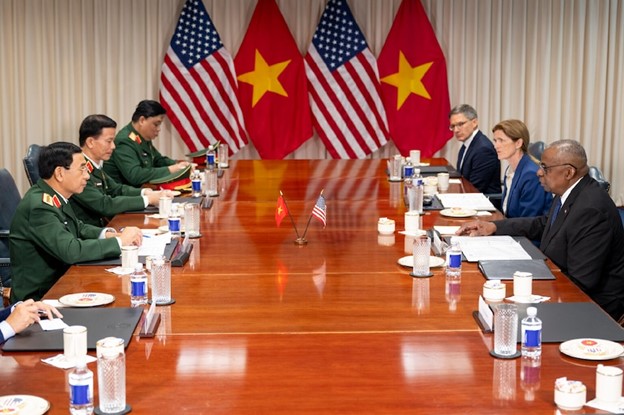China’s aggression and coercion in the Indo-Pacific region is bringing together nations that were once enemies.
The U.S. State Department notes that “Across much of the Indo-Pacific region, the Chinese Communist Party (CCP) is using military and economic coercion to bully its neighbors, advance unlawful maritime claims, threaten maritime shipping lanes, and destabilize territory along the periphery of the People’s Republic of China (PRC)…As the PRC’s overseas economic and security interests expand under its One Belt One Road initiative (BRI or OBOR), it seeks to expand its overseas military footprint to protect those interests. Specifically, the PRC seeks to establish global logistics and basing infrastructure to allow the People’s Liberation Army (PLA) to project and sustain military power at greater distances. [there are] secret military agreements between China and Cambodia. A Chinese military presence in Cambodia could threaten…regional stability. Beijing’s claims to offshore resources across much of the South China Sea are widely denounced as unlawful. Beijing uses intimidation to undermine the sovereign rights of Southeast Asian coastal states in the South China Sea, bully them out of offshore resources, threaten them out of shipping lanes, assert unilateral dominion, and deprive fishermen of access to their livelihoods. “
Among those nations coming together are the United States and Vietnam.
At a meeting with Hanoi’s Defense Minister General Phan Van Giang, Secretary of Defense Lloyd Austin stated that America is committed to strengthening ties with Vietnam. Among the measures taken are boosting the southeast Asian nation’s industrial base resilience and strengthening its maritime awareness and defense capabilities.
The moves come at a time when Hanoi has expressed concern about China’s aggression towards Vietnamese fisherman, reports the Voice of America, which noting that Hanoi has formally protested China’s reported behavior toward fishermen near the disputed Paracel Islands. “The Vietnamese Foreign Ministry …blamed Chinese law enforcement personnel for the attack, saying they had ‘seriously violated Vietnam’s sovereignty in the Paracel Islands,’ in addition to international law and an agreement by the leaders of the rival claimant countries to better handle their territorial disputes.”
Vietnam shares being on the receiving end of Beijing’s aggression with the Philippines, which has been victimized by China for decades. DW reports that “Vietnam and the Philippines are both at odds with China over its sweeping territorial claims and growing military presence in the South China Sea.” Both nations agreed this summer Vietnam and the Philippines to enhance their defense links and work more closely together on maritime security.
The U.S. military is enhancing its own defense ties with the Philippines. Last July, Eli Ratner, the U.S. Assistant Secretary of Defense for Indo-Pacific security affairs, stated that “We have elevated the U.S.-Philippines alliance to stand among our most vital defense partnerships in the world. We have raised the profile of alliance engagements.” According to the Pentagon, part of this is the agreement for U.S. rotational presence in the Philippines. The two nations have also taken major steps to increase interoperability, and the U.S. military is working closely with the Philippines’ armed forces on force modernization. “… we have pursued new opportunities together with the Philippines to cooperate multilaterally with like-minded partners across the Indo-Pacific in support of a shared vision for a free and open region,” Ratner noted.
In May, Australian Deputy Prime Minister and Minister for Defence Richard Marles, Japanese Minister of Defense Kihara Minoru, and U.S. Secretary of Defense Lloyd Austin III convened a Trilateral Defense Ministerial Meeting in Hawaii. The three nations expressed strong opposition to any attempts by China to unilaterally change the status quo by force or coercion in the South and East China Seas. This includes concerning and destabilizing actions in the South China Sea, such as unsafe encounters at sea and in the air, the militarization of disputed features, and the dangerous use of coast guard vessels and maritime militia, including interference with routine maritime operations, and efforts to disrupt other countries’ offshore resource exploration.
Photo: U.S. and Vietnam Defense officials meet to discuss China (DoD photo)
